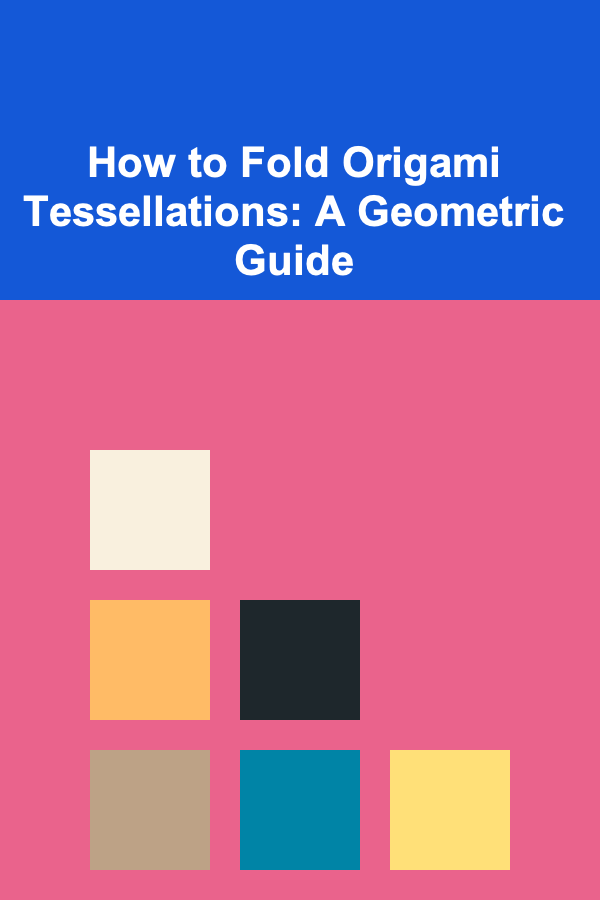
How to Fold Origami Tessellations: A Geometric Guide
ebook include PDF & Audio bundle (Micro Guide)
$12.99$8.99
Limited Time Offer! Order within the next:

Origami, the Japanese art of paper folding, has evolved far beyond its traditional forms into a world of intricate, geometric designs, including the fascinating domain of tessellations. These tessellations, repeating patterns that interlock and cover an entire surface without gaps, are an artistic marvel and a challenge for both beginners and seasoned origami enthusiasts. Understanding how to fold origami tessellations involves both an appreciation for the geometry behind them and the patience to learn the techniques step by step.
In this guide, we'll explore the basics of origami tessellations, their geometric foundations, and how to approach the folding process. Whether you're a seasoned origami practitioner or a curious beginner, this guide will provide valuable insights into creating beautiful, intricate tessellations that transform a simple square of paper into stunning works of art.
Understanding the Geometry of Origami Tessellations
At their core, origami tessellations are made by folding paper in a precise and regular manner, such that the resulting pattern repeats itself across the surface. The beauty of tessellations lies in the way they mimic the mathematical concept of tiling---a method of covering a surface using shapes that fit together perfectly.
Geometric Principles
The main geometric principles behind origami tessellations are:
- Symmetry: Tessellations often involve symmetrical patterns. These patterns repeat themselves across axes or centers, creating visually satisfying and harmonious effects.
- Angle of Fold: The folds used in tessellations often involve sharp creases that help divide the paper into smaller sections. The angles of these folds determine how well the pattern will repeat and interlock.
- Grid System: Many tessellations start with a grid-like pattern, where the paper is divided into a series of squares or triangles. The geometric relationship between these grid lines guides how the folds will be applied.
- Scalability: Tessellations are often scalable, meaning that once a basic unit is folded, it can be repeated across a surface to form a larger pattern.
Understanding these geometric principles is essential when attempting to fold origami tessellations. Each fold must be executed with precision to ensure that the paper lines up correctly, and the resulting pattern is symmetrical and repeatable.
Preparing the Paper for Tessellations
Before diving into the folding process, it's important to start with the right kind of paper. Tessellations often require paper that can hold sharp creases, as many folds need to be precise and clean.
Choosing the Right Paper
- Thickness: Origami tessellations usually require thin, crisp paper, as thick paper may be difficult to fold accurately. Standard origami paper (about 70-80 gsm) is a good choice for beginners, though you can experiment with different textures and weights as you become more experienced.
- Size: Start with square paper for ease of folding. For most tessellations, the paper should ideally be in a 1:1 ratio, meaning a perfect square. Begin with a smaller size like 6"x6" (15 cm x 15 cm) for simpler designs and gradually scale up as you progress.
- Precreasing: Before folding your tessellation, it's useful to precrease your paper. Precreasing involves making creases in the paper before actually performing the main folds. This helps to create a clearer guide for where to fold the paper in subsequent steps. A light pencil grid or use of a ruler to mark fold points can also be helpful.
Basic Techniques in Origami Tessellations
Origami tessellations combine traditional origami folds with innovative techniques that require more advanced folding skills. Before diving into more complex tessellation patterns, it's essential to master a few basic origami folds that form the foundation for more intricate designs.
1. Mountain and Valley Folds
The two most basic types of folds are the mountain fold and valley fold:
- Mountain Fold: This fold creates a peak on the paper, like a mountain ridge. To create a mountain fold, fold the paper so the two edges meet, then crease sharply and unfold.
- Valley Fold: A valley fold creates a trough-like shape. To make this fold, bring the edges together in the opposite direction of the mountain fold.
These basic folds are fundamental in creating sharp, structured shapes that are necessary for creating consistent tessellations.
2. Squash Fold
The squash fold is a technique that allows you to flatten a section of the paper to create a new shape. It's used to expand or manipulate the paper in a way that allows for more complex folds to follow.
To perform a squash fold:
- Begin by making a preliminary valley or mountain fold.
- Open the fold and flatten the paper into a new shape.
Squash folds are often used in the creation of smaller, repeating units in tessellations, allowing the paper to form a regular pattern.
3. Reverse Fold
A reverse fold involves turning a fold inside out. To perform this fold, you make a preliminary fold in the direction opposite to the final fold and then reverse the direction, flattening the paper as you go. This technique allows for the creation of intricate geometric patterns that require folding in both directions.
4. Pleat Fold
Pleat folding involves folding the paper back and forth in an accordion style. These folds are often used to create layers or intricate surfaces that are common in tessellation patterns.
Step-by-Step Folding Process for Simple Tessellations
Once you've familiarized yourself with the basic folds, you can start creating tessellations. Below is a general step-by-step guide for folding a basic tessellation design. We'll begin with a simple design---a honeycomb tessellation---before moving on to more complex designs.
Step 1: Precrease the Paper
Start with a square sheet of paper. Begin by lightly creasing the paper both diagonally and vertically to create a grid. Use a pencil to mark the fold lines so you can easily identify the folding directions in later steps.
Step 2: Make Preliminary Folds
Next, fold the paper into smaller squares. Begin by folding each edge of the square towards the center, creating a smaller square. Unfold and repeat for each side of the paper. This helps to define a series of smaller units that will form the basis of your tessellation.
Step 3: Create the Honeycomb Shape
Once you have the creases in place, begin creating the honeycomb shape by folding along the pre-established lines. To do this:
- Use a series of mountain and valley folds to pinch the paper into the desired shape.
- Carefully collapse the folds together, paying attention to the symmetry of the pattern.
Step 4: Refine the Shape
At this point, you should have the basic honeycomb tessellation structure. Continue refining the shape by gently flattening the paper and ensuring all the edges are aligned. This will help solidify the repeating pattern.
Step 5: Expand the Tessellation
To expand the tessellation, you can repeat the folding pattern across the paper. As you fold, the tessellation will grow into a larger, more intricate design. With practice, you can achieve an interconnected pattern that covers the entire surface.
Advanced Tessellation Patterns
Once you've mastered basic tessellation techniques, you can begin experimenting with more complex designs. Here are a few advanced tessellation patterns that you can explore.
1. Zig-Zag Tessellation
A zig-zag tessellation pattern involves folding the paper into a series of sharp peaks and valleys, creating a continuous zig-zag shape across the surface. This tessellation often looks like waves or scales, adding texture and depth to the paper.
2. Dragonfly Tessellation
This pattern involves creating a series of interlocking shapes that resemble dragonfly wings. It requires advanced pleating and squash folds to form the symmetrical shapes.
3. Complex Star or Flower Patterns
More intricate tessellations may involve layering folds and using reverse or squash folds to create star-shaped or floral patterns. These designs can be quite elaborate, often requiring dozens of precise folds to achieve a clean, symmetrical result.
4. 3D Tessellations
Once you've gained confidence in 2D tessellation designs, you can experiment with 3D tessellations. These patterns incorporate additional folds to create depth and volume, giving your tessellation a sculptural quality. Folding multiple layers of paper or integrating a series of modular tessellations can help create 3D effects.
Tips for Success in Folding Tessellations
While folding tessellations is an exciting and rewarding process, it can also be challenging. Here are some tips to help you succeed:
- Take Your Time: Tessellations require patience. It's important to take your time with each fold to ensure that the pattern is accurate.
- Use Tools: If necessary, use a bone folder or a similar tool to press down your folds. This will help create sharp, precise creases.
- Practice Symmetry: Tessellations depend on symmetry, so double-check that your folds are even and aligned correctly before proceeding to the next step.
- Start Simple: Begin with basic tessellation patterns and gradually progress to more intricate designs as you build your skills.
Conclusion
Origami tessellations represent a beautiful marriage of art and mathematics, transforming a single sheet of paper into an intricate, repeating design. By understanding the geometric principles behind tessellations and mastering the basic folding techniques, you can begin creating these stunning patterns. With patience and practice, you'll be able to push the boundaries of paper folding and develop your own unique tessellation designs. Whether you're folding simple honeycomb shapes or complex 3D patterns, the world of origami tessellations offers endless possibilities for creativity and geometric exploration.
Reading More From Our Other Websites
- [Home Renovating 101] How to Replace Windows and Doors: Choosing the Right Style for Your Home's Architecture
- [Home Cleaning 101] How to Create a Move-In Cleaning Checklist: A Step-by-Step Guide
- [Horseback Riding Tip 101] Innovative Riding Accessories: The Latest Tech and Trends in Equestrian Gear
- [Beachcombing Tip 101] From Shells to Starlight: A Day-by-Day Guide to Low-Tide Beachcombing Adventures
- [Organization Tip 101] How to Involve Your Neighbors in Home Security Strategies
- [Home Staging 101] How to Stage My Home for Different Seasons: Seasonal Tips
- [Screen Printing Tip 101] Eco-Friendly Ink & Sustainable Practices in Screen Printing Art
- [Home Security 101] How to Get Neighbors Involved in Home Security and Safety
- [Home Maintenance 101] How to Choose and Install a Smart Thermostat
- [Home Rental Property 101] How to Handle Short-Term Rental Properties and Airbnb

How to Decorate Your Kitchen with Holiday Accents for a Cheerful Vibe
Read More
How to Organize Your Recipe Collection for Easy Cooking
Read More
How to Use Deep Learning for Automating Income Generation
Read More
Understanding Bird Molting Seasons: A Comprehensive Guide
Read More
How to Build an Emergency Fund with Side Hustle Income
Read More10 Tips for Tracking Augmented Reality (AR) Market Trends and Adoption
Read MoreOther Products

How to Decorate Your Kitchen with Holiday Accents for a Cheerful Vibe
Read More
How to Organize Your Recipe Collection for Easy Cooking
Read More
How to Use Deep Learning for Automating Income Generation
Read More
Understanding Bird Molting Seasons: A Comprehensive Guide
Read More